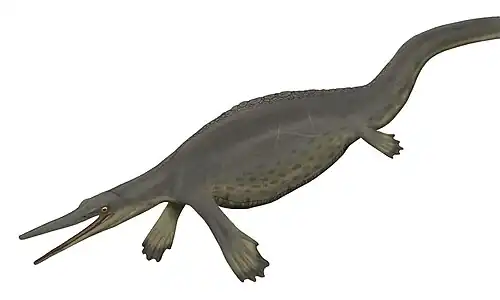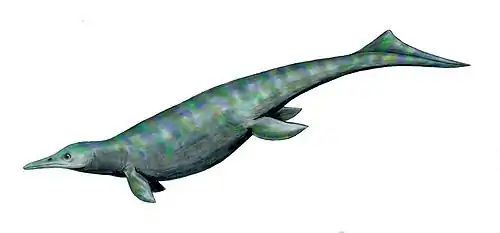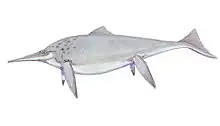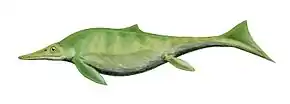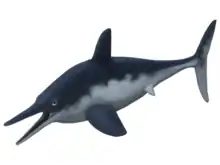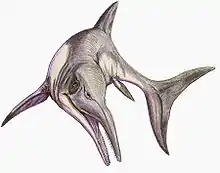Grendelius
Grendelius is a genus of platypterygiine ophthalmosaurid ichthyosaur from the Late Jurassic (Kimmeridgian-Tithonian) of the UK and European Russia. It was a medium-sized ichthyosaur measuring about 4 metres (13 ft) long.[1]
| Grendelius Temporal range: Late Jurassic, | |
|---|---|
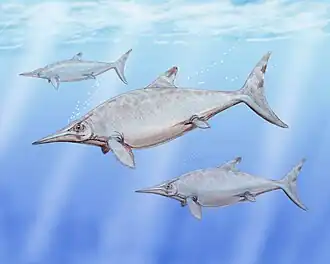 | |
| Life restoration of Grendelius zhuravlevi | |
| Scientific classification | |
| Domain: | Eukaryota |
| Kingdom: | Animalia |
| Phylum: | Chordata |
| Class: | Reptilia |
| Order: | †Ichthyosauria |
| Family: | †Ophthalmosauridae |
| Genus: | †Grendelius McGowan, 1976 |
| Species | |
| Synonyms | |
|
Otschevia Efimov, 1998 | |
Taxonomy

The type species, Grendelius mordax, was described in 1976 on the basis of CAMSM J.68516, a complete skull with associated postcranial elements from the Kimmeridge Clay of England.[2] Later, it was reassigned to Brachypterygius because differences between the two species were considered insufficient to warrant separate genera, or even species.[3][4]
Efimov, 1998 named a new genus of ichthyosaur, Otschevia pseudoscythica on the basis of a single specimen (the holotype) from the Pseudoscythia Zone (late Tithonian stage of the Late Jurassic) of Ulyanovsk, Volga region, Russia.[5] Later, Arkangelsky, 1998 described Brachypterygius zhuravlevi from a Tithonian-stage locality in Saratov, Russia, subsequently referring it to Otschevia zhuravlevi.[6][7] Maisch & Matzke, 2000 considered both Russian taxa to be synonyms of each other, and referred the new combination B. pseudoscythicus to Brachypterygius.[8] Thus, Grendelius and Otschevia are considered to be junior synonyms of Brachypterygius. Arkhangelsky named Otschevia alekseevi in 2001, also from the Late Jurassic of Russia.[9] While McGowan and Motani (2003) considered these Russian taxa to be junior synonyms of B. extremus,[4] Maisch (2010) retained them, and B. mordax, as separate species.[10] A paper published in 2015 found Grendelius to be generically distinct from the Brachypterygius type species and more derived within Platypterygiinae, being more closely related to Platypterygius than to Brachypterygius. Otschevia was considered to be a junior synonym of Grendelius.[1]
The following cladogram shows a possible phylogenetic position of Grendelius in Ophthalmosauridae according to the analysis performed by Zverkov and Jacobs (2020).[11]
| Ophthalmosauria |
| ||||||||||||||||||||||||||||||||||||||||||||||||||||||||||||||||||||||||||||||||||||||||||||||||||||||||||||||||||||||||||||||||||||||||||||||||||||||||||||||||||||||||||||||||||||||||||||||||||||||||||||||||||||||||
References
- Zverkov, N. G.; Arkhangelsky, M. S.; Stenshin, I. M. (2015). "A review of Russian Upper Jurassic ichthyosaurs with an intermedium/humeral contact. Reassessing Grendelius McGowan, 1976". Proceedings of the Zoological Institute. 318 (4): 558–588. doi:10.31610/trudyzin/2015.319.4.558.
- McGowan C. 1976. The description and phenetic relation-ships of a new ichthyosaur genus from the Upper Jurassic of England. Canadian Journal of Earth Sciences 13: 668–683.
- McGowan, C. 1997. The taxonomic status of Grendelius mordax: a preliminary report. Journal of Vertebrate Paleontology, 17, 428–430. doi:10.1080/02724634.1997.10010986
- McGowan, C. & Motani, R. Ichthyopterygia. In Sues, H.-D. (ed.) Handbook of Paleoherpetology, vol. 8. Verlag Dr. Friedrich Pfeil, Munich, 175 pp., 19 pls.
- Efimov VM. 1998. An Ichthyosaur, Otschevia pseudoscythica gen. et sp. nov. from the Upper Jurassic Strata of the Ulyanovsk Region (Volga Region). Paleontologicheskii Zhurnal 32 (2): 187-191.
- Arkhangelsky, M. S. 1998. On the ichthyosaurian fossils from the Volgian stage of the Saratov Region. Paleontologicheskii Zhurnal, 1998, 87–91.
- Arkhangelsky, M. S. 2000. On the ichthyosaur Otschevia from the Volgian Stage of the Volga Region. Paleontological Journal, 34, 549–552.
- Maisch MW, Matzke AT. 2000. The Ichthyosauria. Stuttgarter Beiträge zur Naturkunde, Serie B (Geologie und Paläontologie) 298: 1-159
- Arkhangelsky, M. S. 2001. On a new ichthyosaur of the genus Otschevia from the Volgian Stage of the Volga Region near Ulyanovsk. Paleontological Journal, 35, 629–635.
- Michael W. Maisch (2010). "Phylogeny, systematics, and origin of the Ichthyosauria – the state of the art" (PDF). Palaeodiversity. 3: 151–214.
- Nikolay G. Zverkov; Megan L. Jacobs (2020). "Revision of Nannopterygius (Ichthyosauria: Ophthalmosauridae): reappraisal of the 'inaccessible' holotype resolves a taxonomic tangle and reveals an obscure ophthalmosaurid lineage with a wide distribution". Zoological Journal of the Linnean Society. 191: 228–275. doi:10.1093/zoolinnean/zlaa028.
